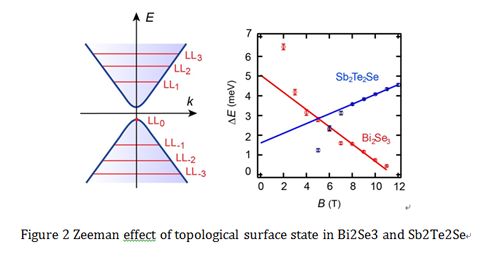On February 24th, Professor Ying-Shuang Fu in School of Physics and his team made breakthrough in research on topological quantum states by publishing in Nature Communications, entitled as “Observation of Zeeman effect in topological surface state with distinct material dependence”.
Solids are classified into metals, semiconductors and insulators according to their difference in electrical conductivity. This classification is well-understood under the frame of solid band theory. Insulators process a band gap and thus no flowing electrons exist in the gap that contributes to conductivity. Recently, topological insulators are discovered, which expand our understanding beyond the well-established band theory. In such materials, while the inside bulk is insulating, a metallic surface state emerges on the surface. The so-called topological surface state is guaranteed to exist due to the special topological symmetry of the band. Intriguingly, the electrons of the topological surface state are massless, and have absent spin degeneracy. Manipulating spins of the topological surface state can drive the electrons massive, which leads to novel quantum physical phenomena and exciting potential applications. As a consequence, the study of topological materials has become one of the most forefront researches in condensed matter physics and material science.
Currently, the spins of the topological surface state are manipulated via doping the topological insulator compounds with magnetic atoms. The method has proven very effective, but it causes problems such as inhomogeneity and weakened spin-orbit coupling. By applying an external magnetic field, the spins are manipulated through their coupling to the magnetic field, which effect is known as Zeeman effect. Since the external magnetic field is precisely controllable and homogeneously distributed over the topological insulator compounds, this approach has obvious advantages over that of the magnetic doping. However, the topological insulator samples are not perfect. They contain defects that charge the crystals. This brings difficulties to the observation of the Zeeman effect by conventional quantum oscillation measurements, and the reported results are thus largely controversial.
Ying-Shuang Fu and his team developed a real-space spectroscopic imaging technique based on scanning tunneling microscopy. With this technique, they directly probed the zero-mode state due to the orbital quantization caused by the magnetic field. According to the theoretical understanding, such a state exhibits the most prominent Zeeman effect, but hardly measurable by the afore mentioned quantum oscillation methods. They constructed a model which excludes the extrinsic effects originating from the potential fluctuations and non-ideal band dispersions of the actual topological materials. This allows them to unambiguously observed the Zeeman effect. They applied this technique to two topological materials Bi2Se3 and Sb2Te2Se. The two materials exhibit distinctly different surface g-factor, which is a proportion prefactor characterizing the Zeeman coupling strength (Figure 2). This remarkable result not only sets a foundation for its further theoretical advancements but also opens up a new knob in controlling the topological surface state.

Ying-Shuang Fu joined School of Physics of HUST as a professor in August of 2014. He was granted the “National Science Fund for Excellent Young Scientist” in 2015. He has been working in the fields of low dimensional quantum systems, spin manipulation of single quantum states and novel effects in quantum materials, whose obtained research results have attracted wide attention. The paper introduced above is another breakthrough in topological quantum states after his last publication in Nature Physics in December of 2014.
This work is supported by the HUST Talent Fund, and the General Program of National Science Foundation of China.
